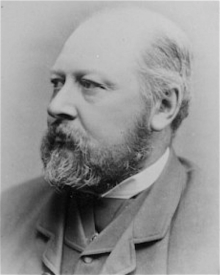
Alexander Ross was born at Huntly Hill in the parish of Stracathro, Forfarshire, Scotland on 9 July 1834 and was the son of the architect James Ross (1800-1853) and moved with his family to Inverness in 1842. He was articled to his father from c.1848 to c.1852 and worked as his assistant for a further year. With the death of his father in 1853 he took over his practice. In 1859 he formed a partnership with William Cummings Joass (1833-1919) as Ross & Joass. Following the dissolution of the partnership in 1865, Ross worked alone until c.1875 when he formed Ross & Mackintosh, a partnership with David Mackintosh (c.1850-1891). This partnership was dissolved in 1883, and in 1887 Ross formed a third partnership, Ross & Macbeth, with Robert John Macbeth (1857-1912). This partnership was dissolved in 1907 and that year Ross formed a final partnership, Alexander Ross & Son, with his son, John Alistair Ross (1882-1955).
During his long career as an architect it has been calculated that Alexander Ross designed over 650 buildings
He was elected a Fellow of the Royal Institute of British Architects (FRIBA) in 1893 and was President of the Inverness Architectural Association from 1917 to 1920 He was awarded an Honorary Doctorate by St. Andrews University in 1891.
His address was given as 42 Union Street, Invernesss in 1868 and 1870; Riverfield, Inverness in 1893 and 1925; and Queensgate Chambers, Inverness in 1914 and 1923. He died at his home, Riverfield, Island Bank Road, Inverness on 19 May 1925.
Alexander Ross and his practices specialised in the design of churches and religious buildings, schools, banks and police stations, mainly in the Scottish Highlands. Churches and religious buildings included St Ninian's Episcopal Church, Glen Urquart (1853); St Finan's Episcopal Church, Kinlochmoidart (1854); Episcopal Church, Ballachulish (1854); St Finan's Episcopal Church, Kinlochmoidar (1854); St Columba's Episcopal Church, Nairn (1857); St Saviour's Episcopal Church, Bridge of Allan (1857); Invergordon Free Church (1859); Stratherrick Roman Catholic Church, Dalcraig (1859); Kilmuir Free Church and manse, Skye (1860); Church of St Droslain, Aberlour (1861); Alness Church (1862); Urray Church and manse (1862); St Matthew's Episcopal Church, Old Meldrum (1863); Union St United Presbyterian Church, Inverness (1863); Glenshiel Free Church (1864); United Presbyterian church, Queen Street, Inverness (1864); Glengarry Established Church (1865); St Andrew's Cathedral, Inverness (1866); St Andrew's Episcopal Church, Wick, Caithness (1868); Laurencekirk Episcopal Church (1871); Nigg United Presbyterian Church (1871); St Columba's Episcopal Church, Isle of Mull; St Cyprian's Episcopal Church, Lenzie (1872); All Saints Episcopal Church, Buckie (1875); Bishop's Palace, Inverness (1875); St Margaret's Episcopal Church, Aberlour (1875); St Olaf's Episcopal Church, Kirkwall (1875); Episcopal Church of St Columba, Largs (1876); Trinity United Presbyterian Church, Banff (1879); St Mary's Episcopal Church, Glencoe (1880); St Michael's Episcopal Church, Dufftown (1880); Duncansburgh Parish Church, Fort William (1881); Holy Trinity Episcopal Church, Keith (1882); St Peter and the Holy Rood Episcopal Church, Thurso (1883); Halkirk Free Church (1884); St Columba Episcopal Church, Portree (1884); Chapel of the Holy Spirit, Inverness (1886); Mission Church, Inverness (1886); St Andrew's Episcopal Church, Tain (1887); St Andrew's Episcopal Church, Brechin (1888); St Columba's Mission Hall, Inverness (1889); Episcopal Mission Church, Inverness (1890); Free North Church, Inverness (1890); Stromeferry Free Church Mission Hall; St Bride's Episcopal Church, Onich (1891); Cromdale Parish Church (1892); St Columba's Episcopal Church, Grantown-on-Spey (1892); St Columba's Chapel and Bishop's House, Iona (1893); Dochfour Memorial Church (1894); St Drostan's Episcopal Church, Insch (1894); St Barnabas Episcopal Church, Paisley (1895); Clydebank Episcopal Church (1895); Gairloch Free Presbyterian Church (1896); Struy Free Church (1896); St Kessog's Episcopal Church, Auchterarder (1897); Ardross Church (1898); Free Presbyterian Church, Raasay (1898); Cumming Street United Free Church, Forres (1899); Free Presbyterian Church, Inverness (1899); Courthill Episcopal Chapel, Lochcarron (1901); Kingussie Episcopal Chapel (1903); St Michael and All Angels Episcopal Church, Inverness (1903); Auchterarder Church (1906); St Regulus Episcopal Church, Cromarty (1906); Latheron United Free Church (1909); and St Finnbar's Episcopal Church, Dornoch (1912).
Schools designed by them included Kilmonivaig School (1860); Reid School, Dingwall (1863); Mackenzie Foundation Episcopal School, Avoch (1864); Nairnside School (1864); St Clement's School, Dingwall (1864); Applecross School (1872); and Riding School, Inverness (1909).
Banks designed by them included Bank of Scotland, Nairn (1864); Caledonian Bank, Bonar Bridge (1865); Caledonian Bank, Lochcarron (1873); Caledonian Bank, Dornoch (1890); Caledonian Bank, Burghead (1890); Caledonian Bank, Glenurquhart (1895); Clydebank Episcopal Church (1895); and Caledonian Bank, Fort Augustus (1903).
Police stations designed by them included Castlebay Police Station, Barra (1892); Dunvegan Police Station (1892); Tarbert Police Station (1892); Campbelltown Police Station (1893); Fort Augustus Police Station (1893); Ardersier Police Station (1897); Boat of Garten Police Station (1900); Nethybridge Police Station (1900); Mallaig Police Station (1902).
Other buildings designed by them included Dunvegan Hotel, Skye (1868); Achnasheen Station Hotel; Inverness Artillery Drill Hall (1871); Inverness Tweed Mill (1877); Inverness Artillery Volunteer Hall (1889); Golf Clubhouse, Nairn (1892); Aviemore Station Hotel (1899); Hugh Miller Institute, Cromarty (1902); Inverness Sailors Home (1904); Skating Rink, Inverness (1909); La Scala Cinema, Inverness (1913); Territorial Army Drill Hall, Fort Augustus (1913); and Territorial Army Drill Hall, Broadford, Skye (1914). In 1917 they converted distillery buildings in Dalmore and Glenalbyn into bases for the United States Navy.
For more detailed lists of architectural projects by Alexander Ross see:
Dewar, Ramsay. ‘St Andrew's Church, Fort William’. [Architects (1880): Alexander Ross] Church Building no. 48, 1997 November/December, p.p 10-11.
Directory of British Architects 1834-1914. Compiled by Antonia Brodie, et al. Volume 2: L-Z. London; New York: British Architectural Library, Royal Institute of British Architects/Continuum, 2001
Miers, Mary. ‘Ardtornish’. [House in Argyll & Bute, Scotland designed by Alexander Ross in the 1880s] Country Life vol. 200, no. 1, 5 January 2006 pp. 48-52.
‘Obituary’. RIBA Journal vol. 33, 1926, p. 64